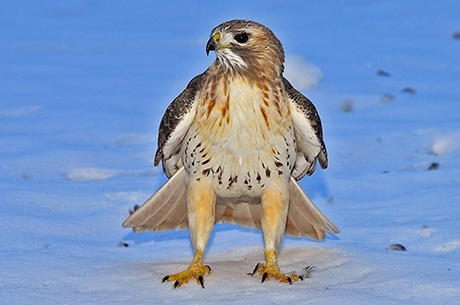
While visitors to St. John’s University’s Queens, NY, campus are likely familiar with Johnny Thunderbird, the mascot of Red Storm Athletics, those who live, study, and work on campus are aware that there are real birds of prey residing high above the property—a family of red-tailed hawks.
Perched upon their nest built years ago on a Belson Stadium light tower, the hawks have an unobstructed view of their territory—which includes the University’s 102-acre campus, as well as parts of the surrounding neighborhoods of Jamaica Estates, Jamaica Hills, and Fresh Meadows.
“The red-tailed hawks on the Queens campus are a welcome sight,” said Thomas M. Goldsmith, Director of Energy and Sustainability, Department of Campus Facilities and Services. “I would like to believe that the campus’s dense tree canopy has contributed to a more natural habitat for the hawks.”
Throughout the year, the hawks can be seen perched atop various campus buildings, or near the Great Lawn searching for prey, or collecting sticks and branches they use to fortify their nest.
“This species of hawk is quite common in New York City,” said Kaitlyn L. Parkins, Conservation Biologist, New York City Audubon. “Queens provides a good habitat for red-tailed hawks, because there is a good deal of open space here, along with plenty of structures for them to build their nest upon.”
Resilient and adaptable, the species survives on a diet of rodents, such as squirrels and mice, as well as smaller birds, such as pigeons. “There is a high concentration of food sources for them in the city,” she added. “They do not need to go very far to find something to eat.”
St. John’s location in Queens likely plays a crucial role in the presence of hawks on campus—it stands directly between two of the borough’s largest parks, Alley Pond Park and Forest Park.
“There are red-tailed hawk pairs dotted throughout the borough,” said Bobby Horvath, who runs WINORR–Wildlife in Need of Rescue and Rehabilitation, a nonprofit, volunteer organization that provides professional care for sick, injured, and orphaned wildlife throughout New York City, Nassau County, and Western Suffolk County.
“There is the pair at St. John’s, a pair that lives in the Unisphere in Flushing Meadows–Corona Park, and another pair that lives on the grounds of the New York State Veterans' Home at St. Albans, Queens,” said Mr. Horvath. “It is likely that every major park in Queens is inhabited by red-tailed hawks.”
Queens is home to other birds of prey, as well, including peregrine falcons, ospreys, and great horned owls, due to the borough’s mix of urban and suburban communities, parks and woodlands, and miles of shoreline.
In recent years, bald eagles have also been spotted in Forest Hills, Kew Gardens, and Flushing. In 2017, it was reported that a pair of eagles had built a nest on the campus of William A. Shine Great Neck South High School, near the Queens–Nassau County border.
Red-tailed hawks mate for life, and each spring, females lay between one and four eggs. Following an incubation period of 28 to 35 days, those eggs hatch. Six weeks after that, the birds fledge, a process that involves growing the feathers necessary for flight.
“We know when the red-tails are hatching,” said Ms. Parkins, “because that is when we start to get calls about young hawks showing up in places where they might get into trouble, like the FDR Drive or the middle of a street in the Bronx.”
St. John’s hawks gained notoriety in 2016, when an adult hawk who was protecting a young fledgling became aggressive toward two employees on campus.
“In the wild, these fledglings can spend days or even weeks walking around in the woods unnoticed, until they are ready to fly,” said Mr. Horvath. “In urban or residential areas, they do not have anywhere to hide.”
Eventually, the young hawks learn to hunt on their own, and they leave the nest in search of their own mates and new territories like the sprawling, park-like campus of St. John’s to call home.
